

LASR - Longitudinal Analysis and Self Registration. LASR - Data Mining Tool for Rehabilitation Engineering Data Xiaofeng Wang1,2, Jiayang Sun1 and Kath Bogie1,3 Case Western Reserve University1, The Cleveland Clinic2 and Cleveland FES Center3.

Wireless Sensor Network Technologies for the Information Explosion Era - Takahiro Hara. AAAS News Release - "Science: Monitoring Vital Signs through Stretchable Electronic Skin" An ultra-thin electronic device attaches to the skin like a temporary tattoo and measures heart rate and other vital signs without the bulky electrodes used in current hospital monitoring, reports a new study in the 11 August issue of the journal Science.
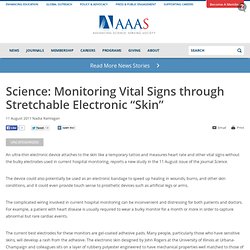
The device could also potentially be used as an electronic bandage to speed up healing in wounds, burns, and other skin conditions, and it could even provide touch sense to prosthetic devices such as artificial legs or arms. The complicated wiring involved in current hospital monitoring can be inconvenient and distressing for both patients and doctors. For example, a patient with heart disease is usually required to wear a bulky monitor for a month or more in order to capture abnormal but rare cardiac events. The current best electrodes for these monitors are gel-coated adhesive pads. Many people, particularly those who have sensitive skins, will develop a rash from the adhesive.
[Video courtesy of John A. 112661. 59_14_43.pdf. [1106.3881] A fully woven touchpad sensor based on soft capacitor fibers. A pressure mapping device with Bragg grating sensors inscribed in bow-tie fibres. A wireless gait analysis sys... [Conf Proc IEEE Eng Med Biol Soc. 2009. Application of a Fiber Optic Distributed Strain Sensor System to Woven E-Glass Composite. ATWiki Home - ATWiki. Bio-Sensing. Borza-Textile_actuators_and_textile_sensors.doc. Breathing Feedback System with Wearable Textile Sensors - NUI Maynooth ePrints and eTheses Archive. Mitchell, Edmond and Coyle, Shirley and O’Connor, Noel E. and Diamond, Dermot and Ward, Tomas (2010) Breathing Feedback System with Wearable Textile Sensors.
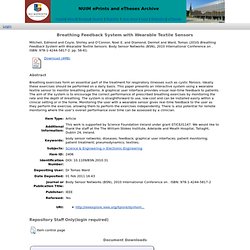
Body Sensor Networks (BSN), 2010 International Conference on . ISBN: 978-1-4244-5817-2. pp. 56-61. Abstract Breathing exercises form an essential part of the treatment for respiratory illnesses such as cystic fibrosis. Evaluation of a new sitting concept designed for prevention of pressure ulcer on the buttock using finite element analysis. Features and Benefits. Home - Paralyzed Veterans of America. HOSPITAL CARE OF OLDER PATIENTS. Human Factors and Ergonomics Society. Iecon09_vitalSignalFINAL.docx. Institute of Industrial Engineers. ISS 2011: Home Page. M04-CL05. Makhsous Contact. pHealth07_paper_J_Luprano_CSEM_v3.doc. PolyU Institutional Repository: Design and development of electrically conducting textile sensors for smart textiles and apparel.
NanoEngineers Print and Test Chemical Sensors on Elastic Waistbands of Underwear. NanoEngineers Print and Test Chemical Sensors on Elastic Waistbands of Underwear June 17, 2010 By Daniel Kane Chemical sensors printed directly on elastic underwear waistbands retained their sensing abilities even after engineers stretched, folded and pulled at the chemical-sensing printable electrodes – sensors that could one day be incorporated into intelligent “hospital-on-a-chip” systems.
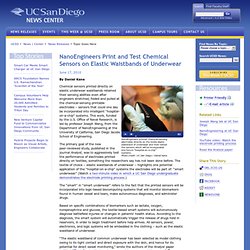
This work, funded by the U.S. Office of Naval Research, is led by professor Joseph Wang, from the Department of NanoEngineering at the University of California, San Diego Jacobs School of Engineering. The primary goal of the new peer-reviewed study, published in the journal Analyst, was to aggressively test the performance of electrodes printed directly on textiles, something the researchers say has not been done before. A 2008 ONR grant announcement from UC San Diego introduced this project. “We just want the ones and zeros. NTF Projects: TWIGS. Pressure changes under the ischial tuberosities of seated individuals during sacral nerve root stimulation. Pressure mapping - ATWiki. From ATWiki Interface pressure mapping involves using sensors to quantify the pressure between two contacting objects, such as a person and their support surface.
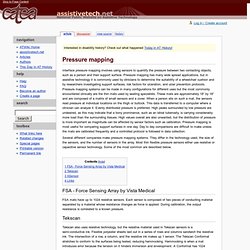
Pressure mapping has many wide spread applications, but in assistive technology it is commonly used by clinicians to determine the suitability of a wheelchair cushion and by researchers investigating support surfaces, risk factors for ulceration, and ulcer prevention protocols. Pressure mapping systems can be made in many configurations for different uses but the most commonly encountered clinically are the thin mats used by seating specialists. These mats are approximately 18” by 18” and are composed of a matrix of small sensors and a cover. When a person sits on such a mat, the sensors read pressure at individual locations on the thigh or buttock.
Pressuremapping. RESNA Home Page. Seeing the Difference - November 2003. Sensing Fabrics, E-Textile Solutions, Flat-Knitting Technology. Abstract In this paper is reported the experience gained in the last five years, in the implementation of wearable systems for personalized health care and their evolution in time.

Sensing bio clothes for vital signs monitoring and wearable systems for gesture and posture recognition are specifically illustrated, resulting from the EU funded projects: Wealthy and My Heart. In the last few years, monitoring systems based on multifunctional instrumented garments are playing an innovative role in the development of more human oriented monitoring devices. Smart fabrics allow the monitoring of patients over extended period, in a natural contest, in biomedicine, as well as in several health-focused disciplines, such as bio-monitoring, rehabilitation, telemedicine, tele-assistance, ergonomics and sport medicine [1]. In this work, it will be report the experiences gained during the last five years in the manufacturing of sensing systems and their evolution in time. A. Sensors for Woven Material (cloth, window screen, gauze) Textile Sensors and Conductive Textile. Scientific innovation floods every television news headlines and newspaper pages.
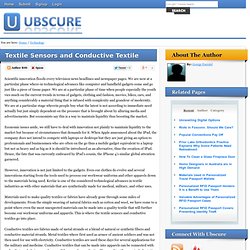
We are now at a particular phase where-in technological advances like computer and handheld gadgets come and go just like a piece of tissue paper. We are at a particular phase of time when people especially the youth vies much on the current trends in terms of gadgets, clothing and fashion, movies, bikes, cars, and anything considerably a material thing that is infused with complexity and grandeur of modernity.
We are at a particular stage wherein people buy what the latest is not according to immediate need actually but just simply dependent on the pressure that is brought about by alluring media and advertisements. But economists say this is a way to maintain liquidity thus boosting the market. Economic issues aside, we still have to deal with innovation not plainly to maintain liquidity to the market but because of circumstances that demands for it. The National Public Website on Assistive Technology. The Sensor Sleeve: Sensing Affective Gestures (Cliff Randell)
The process of communicatingan affective gesture fromone user to the nominated party is as follows: The user performs the desired gesture; The micro-controller in the garment processes inputsignals from the sensors, and outputs signals to theBluetooth device; The signal is then transmitted to the users Bluetooth-enabled cell phone where the signal is examined to seethe type of gesture that has been sensed; A text message with a predefined prefix is then con-structed with a message body indicating the gesturetype.
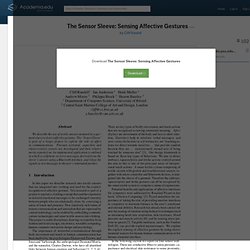
This text message is then automatically sent tothe nominated party’s (partner’s) cell phone; The partner’s cell phone notifies the user of the re-ceived message.This application provided a way for users to trans-mit nonverbalcommunication through body movement andtouch despite being separated. Thick-film textile-based amperometric sensors and biosensors - Analyst. U.S. Rehab - Homepage. UIST-SensorLibrarySubmitted.docx. United Spinal Association. Untitled. You have been redirected to this page for one of the following reasons: Either cookies are not enabled on your browser or Your network configuration is causing cookies to be lost or not function properly. IEEE Xplore requires cookies to maintain sessions and to access licensed content. Cookies are used temporarily to maintain sessions in IEEE Xplore and for no other purpose. Please change your browser settings to accept cookies before you access IEEE Xplore .
Internet Explorer 6, 7, or 8 Click Tools menu. Select Internet Options . Select Privacy tab. Click the Default button or slide the bar down to 'Medium'. Click Ok . For additional information, please refer to Microsoft Help and Support . Firefox 2 or 3 Select Use custom settings for history in the 'Firefox will:' dropdown [v3.5 only] Select the 'Accept cookies from sites' checkbox. For additional information, please refer to the Mozilla Firefox Knowledge Base .
Once you have enabled cookies, you may return to the previous page . Untitled. Untitled. Venous Thromboembolism. Welcome to Ergoweb - The Place for Ergonomics. Welcome to NRRTS - Complex Rehab Technology (CRT), Separate Benefit Category. Wellsense Unveils First-Ever Bedside Patient Pressure Mapping System Designed To Assist Caregivers In Effectively Repositioning Patients. WheelchairNet: a Virtual Community of People who Care about Wheelchairs.